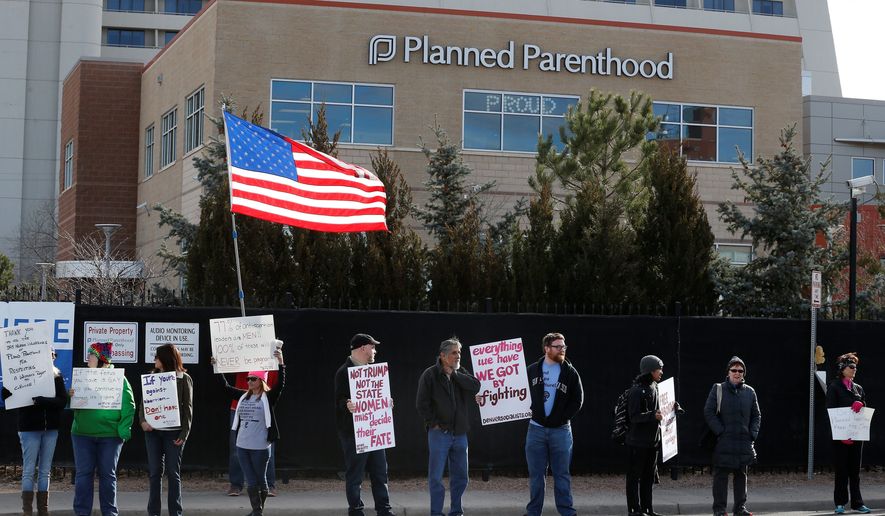As dozens of its clinics closed amid a dwindling U.S. abortion rate, Planned Parenthood has moved to diversify its business model by getting into transgender hormone therapy.
The 2016-17 Planned Parenthood annual report showed the nation’s largest abortion provider struggling to keep its doors open as fewer women undergo abortions and patients seek health care services elsewhere.
In response, “We’re expanding access to care — from pioneering research on self-injectable birth control to offering new services for our transgender patients,” Planned Parenthood President Cecile Richards said in the report’s introductory message.
“Planned Parenthood has focused on expanding services to people who are too often overlooked by the larger medical community — including trans patients,” says the report, released Sunday. “17 states now have Planned Parenthood health centers that provide hormone therapy.”
Providing sex-change therapy may not be enough to reverse Planned Parenthood’s ongoing skid — a 2016 UCLA study found just 0.6 percent of the U.S. adult population identified as transgender — but it offers an opportunity to develop a new client base as women continue to stay away in droves.
The 101-year-old organization’s decline continued last year: Planned Parenthood recorded 2.4 million patients, down slightly from the “more than 2.4 million” in 2016 and a 20 percent decrease from 2010, when the Planned Parenthood boasted 3 million patients.
At the same time, Planned Parenthood lost a whopping $43.4 million in “assets,” including properties, as affiliates shuttered at least 33 clinics, most recently the Dec. 29 closure of a clinic in Iowa’s Quad Cities region.
That was the largest shutdown in recent years — Planned Parenthood shed just $16.7 million in assets in 2016 — amid a decline in the national abortion rate, which has hit its lowest level since the procedure was legalized nationwide by the 1973 U.S. Supreme Court’s landmark Roe v. Wade decision.
A 2016 Guttmacher Institute study found that the abortion rate fell in 2014 to 14.6 per 1,000 women after peaking in 1980 at 29.3, falling for the first time below the 16.3 abortions per 1,000 women immediately after Roe.
Planned Parenthood’s health care centers and clinics performed 321,384 abortions last year, down from 328,348 in 2016, which represented an increase from 323,999 in 2015.
No matter the number, Planned Parenthood invariably reports abortion at 3 percent of its total services.
Other procedures also have declined: Since 2009, Planned Parenthood’s cancer screenings have fallen by two-thirds, while contraception services fell by 30 percent and prenatal care declined by more than 75 percent, according to National Right to Life.
Even so, Planned Parenthood managed to pad its bottom line: The report put total revenue at $1.46 billion in 2017, up from $1.35 billion in 2016, although the share from federal and state grants and payments declined.
Planned Parenthood depends on government health care services grants and reimbursements for roughly half of its income. Last year, that figure was $543.7 million, down from the $554.6 million collected in 2016, which could be attributed to the decrease in patient visits.
“This means that Planned Parenthood is somehow making more money with fewer patients,” Randy O’Bannon, education and research director of the National Right to Life Committee, said in NRL News Today.
How did Planned Parenthood do it? The biggest factor: fundraising. In 2017, the national office and regional affiliates raised $532.7 million in private contributions and bequests, up 19 percent from the $445.8 million raised in 2016.
The rise in revenue and fundraising only bolstered those calling to defund Planned Parenthood.
Mr. O’Bannon said Planned Parenthood for America’s fundraising strength “also illustrates, ironically, that there are nongovernmental sources that PPFA can tap into if states chose to prioritize health funding to full service clinics.”
Kristan Hawkins, president of Students for Life of America, said the report shows Planned Parenthood’s focus remains on abortion despite its efforts to promote its other services.
In 2017, Planned Parenthood did one adoption referral per 38 abortions and provided prenatal care to one woman per 239 abortions, while performing no mammograms, she said.
“The stealth release of Planned Parenthood’s annual report over the holidays shows that the Abortion Goliath is crying crocodile tears all the way to the bank — a fact they clearly hoped no one would notice,” said Ms. Hawkins.
Planned Parenthood touted a number of new and expanded services, including a period-tracking app and Zika education and prevention campaign, as well as transgender-hormone therapy, which is covered by Medicare when “medically necessary,” according to the National Center for Transgender Equality.
Much of the 44-page report is devoted to updates on its political and advocacy work as part of the anti-Trump “resistance,” including its role in the Women’s March and partnerships with Silicon Valley, Hollywood and the fashion industry.
“Congress and this administration will try again to ’defund’ Planned Parenthood and undermine our ability to serve patients whenever they can,” Ms. Richards said in her introductory message. “But as we enter our 101st year, we are stronger and bolder than ever before.”
She received no argument from Mr. O’Bannon.
“Whether PPFA can continue to make money while losing patients, only time will tell,” he said. “But one thing the numbers from this latest annual report tell us: Planned Parenthood, though struggling to hold on to customers, is still a rich and dangerous foe.”
• Valerie Richardson can be reached at vrichardson@washingtontimes.com.




Please read our comment policy before commenting.